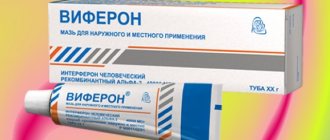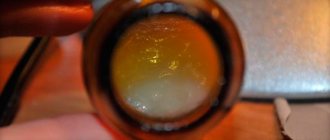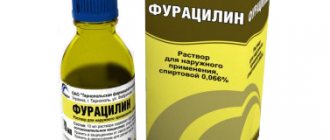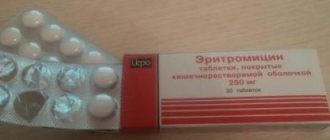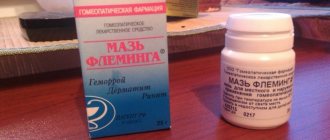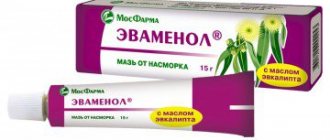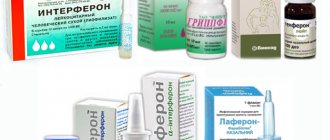Any violation of the integrity of the skin is an open gate for infection, not to mention other possible routes of infection. In such a situation, the main task is to destroy pathogenic microorganisms to prevent the dangerous consequences of their activities. For this purpose, external ointments based on antibiotics are actively used, which help fight infection of wounds and mucous membranes. In the group of such products, it is necessary to highlight Syntomycin Liniment, a long-known and very popular drug.
Synthomycin ointment – emulsion (liniment)
Syntomycin ointment, in fact, is not an ointment. This name is erroneous; in fact, the drug is a liniment, a mixture of oil, liquid and emulsifiers .
Liniment differs from ointment in the composition of the base. Typically, the ointment contains 95-99% petroleum jelly and is a very greasy substance. Liniment contains oil diluted with water with the addition of chemical components.
Since many people are accustomed to calling this drug an ointment, we will also maintain the tradition and not violate generally accepted terminology.
Composition of liniment (ointment)
Synthomycin liniment contains two active ingredients - an antibiotic and an analgesic (syntomycin and novocaine) . The basis of the ointment is natural castor oil , which is not only a formative component, but also exhibits antiseptic and anti-inflammatory properties. Castor oil complements and enhances the effect of the antibiotic.
Syntomycin (chemical term - chloramphenicol
) is similar in structure and action to the antibacterial substance chloramphenicol.
It is syntomycin that provides the effective anti-inflammatory effect of the ointment. It limits the growth of gram-positive microorganisms (streptococci and staphylococci, gonococci and shigella, salmonella and klebsiella)
.
Note: the antibiotic chloramphenicol was invented later than synthomycin and replaced the earlier drug from the treatment of pneumonia, dysentery, gonorrhea, and typhoid. But in external therapy, the use of syntomycin remains popular.
Local use of an antibacterial agent does not lead to its entry into the general bloodstream. Therefore, external treatment with synthomycin does not disturb the intestinal microflora and does not lead to dysbacteriosis.
Synthomycin liniment is a thick gelatinous composition that, when applied to the body, melts and turns into liquid. It is available in three concentrations - 1%, 5%
And
10%
.
Composition and release form
Liniment is produced in aluminum tubes, candles are individually packaged, 10 pieces per pack. The concentration of the ointment can be 10%, 5% or 1%. The color is usually white, but a slight yellowish tint is acceptable. The consistency is homogeneous and thick, with a clearly defined trace. The smell is peculiar, barely audible.
The second important ingredient of synthomycin liniment is castor oil. It not only softens and nourishes tissues, preventing them from dehydration from the effects of antibiotics, but also has an anti-inflammatory effect and resolves nodes. Well promotes the healing of small wounds and cracks.
The last active ingredient is novocaine. This anesthetic contained in syntomycin ointment effectively eliminates the pain syndrome observed during sitting and bowel movements. Which, together with the above action, allows you to comprehensively combat the main symptoms of hemorrhoids.
The drug can be purchased in the following dosage forms:
- liniment with 1%, 5% and 10% active substance content - in aluminum tubes of 25 and 30 grams or in glass jars from 25 to 500 grams, including for use in veterinary medicine;
- vaginal suppositories (candles) 250 milligrams - 10 pieces per package.
The composition of the medicinal product includes the following active ingredients:
- syntomycin;
- Castor oil;
- emulsifiers;
- novocaine.
Syntomycin eliminates bacteria and viruses, prevents the proliferation of microorganisms in hemorrhoids. Castor oil has antibacterial properties, reduces inflammation, eliminates swelling, and softens the skin. Novocaine has an analgesic effect.
Syntomycin ointment is a yellowish substance and has no odor. Release form: tubes of ointment containing 1%, 5% and 10% synthomycin.
Syntomycin ointment is made on the basis of a general-purpose antibiotic - synthomycin, which is also called chloramphenicol, with the addition of castor oil (relieves redness, inflammation and makes the skin softer), water, sodium, carmellose, sorbic acid, ethanol, emulsifier and a small amount of novocaine (provides analgesic effect). All the elements that make up the ointment are combined evenly in it.
Syntomycin ointment is a liniment, and it has only external use: applied to inflamed skin or soft tissue.
Depending on the concentration (from 1 to 10%), the color and smell of the ointment may differ. The color may be pale yellow or white.
The release form of different pharmacological companies is individual. Typically, metal tubes from 25 g to 35 g are more common on sale. Dark-colored jars from 25 g to 1800 are less common. Also in pharmacies you can find suppositories based on synthomycin, each containing 250 mg of active ingredient, but these suppositories are only applicable in gynecology.
What does the instructions for syntomycin ointment say?
The instructions for use of synthomycin ointment provide a list of diseases for which syntomycin is effective. Let's list what synthomycin ointment helps with and what it treats:
- Various infected wounds (injuries and burns, frostbite, accompanied by infection).
- Ulcers, pimples, boils , as well as hidradenitis - the formation of ulcers in the armpits.
Important: synthomycin liniment is not applied to a fresh wound or injury. It is smeared or placed under a bandage several hours or several days after injury.
The ointment is also used in the treatment of gynecological inflammation, hemorrhoids and cracked nipples in nursing women. Or more correctly, it was used in Soviet times, when there were no other treatment options. Today, there are a number of other external medications that are more effective in treatment and safer for an infant. Therefore, synthomycin is not prescribed for the treatment of breasts in a nursing woman .
READ ALSO: Is it possible to smear a boil with iodine: what are the consequences if you burn a boil?
The instructions also contain the following list of contraindications for the use of synthomycin ointment:
- Sintomycin is contraindicated in case of an allergic reaction to the components of the ointment composition .
- For fungal and viral infections (the antibacterial component reduces local immunity and thereby enhances the effect of pathogens).
- In case of hematopoietic disorders (anemia) , synthomycin aggravates the painful processes.
Synthomycin liniment is used to treat more than forty types of diseases. It is effective against bacteria and mites; it is used to treat extensive inflammation, purulent wounds, and infectious rashes. Let's take a closer look at what inflammations liniment is effective for.
Composition and beneficial properties
Synthomycin ointment for hemorrhoids helps thanks to the substances included in its composition:
- syntomycin;
- castor oil;
- novocaine;
- emulsifiers.
The active ingredient is syntomycin (chloramphenicol). This is a chemical element that is similar in microstructure and properties to Levomycetin. The substance actively fights pathogens, bacilli and viruses. Synthomycin liniment even fights viruses that have developed resistance to penicillin. Syntomycin prevents further growth and reproduction of pathogenic viruses in the affected areas of the skin.
Synthomycin liniment fights gram-positive bacteria, namely:
- streptococcus;
- staphylococcus;
- shigella;
- gonococcus;
- neisseria.
This remedy is used in the treatment of many diseases, including hemorrhoids.
The drug is used for therapeutic and prophylactic purposes. Syntomycin ointment is prescribed for:
- boils;
- sycosis;
- trophic ulcers;
- purulent lesions;
- burns;
- cracked nipples.
The ointment is also effective against hemorrhoids. Active substances penetrate deep into the layers of the skin and affect areas of inflammation.
The main active ingredient of syntomycin ointment is chloramphenicol. In addition, it includes:
- emulsifier,
- preservative,
- purified water,
- sodium carboxymethylcellulose,
- Castor oil.
The ointment has high antibacterial activity, relieves inflammation, soothes pain, accelerates the tissue healing process
Use in cosmetics: synthomycin ointment for acne
Synthomycin ointment has found wide use in cosmetology due to its ability to dry inflamed skin. The effect of external use of the antibiotic becomes noticeable after 2-3 days. Thus, after a few days, redness decreases, pimples and ulcers dry out.
If there are only a few pimples, then the ointment is applied pointwise, to each pimple separately. If a large part of the facial skin is covered with acne, the ointment is applied in a continuous layer. For treatment, it is enough to smear your face with ointment 2 times a day (morning and evening) .
For extensive rashes, make a mask of synthomycin, zinc and ichthyol ointment. The components are mixed in equal parts and applied to the face for 10-15, sometimes 20 minutes. After which it is washed off with water. This cosmetic procedure can get rid of severe acne in 10 days.
Note: acne can be treated by simply applying ointment. But when treating a more serious infection - boils - it is necessary to put the ointment under the bandage.
The use of syntomycin ointment for acne on the face in adolescents allows you to survive age-related rashes and do without their extensive manifestation on the face, neck, and neighboring areas of the skin.
And one more thing: synthomycin has a whitening effect. Therefore, it is added to facial skin whitening formulations. They also use synthomycin ointment for age spots.
Instructions for use of the drug
The wide spectrum of action of the drug in question determines its use for a number of diseases and problems with the skin and mucous membranes. The main condition that unites all these situations is the presence of pathogenic microorganisms, since the ointment is still antibiotic. We suggest that you familiarize yourself with the rules for using the product in the most common situations.
This is interesting: How to use sprouted wheat beneficially?
Use on burns and wounds
When you receive a wound or burn to the skin, the first step is to get medical help. The doctor must examine the wound, treat it initially, and, if necessary, surgically remove dead tissue. Only after treatment can syntomycin liniment be applied to the damage. It is applied directly to the wound surface, placing a sterile bandage on top. After surgery, to clean a purulent wound, it is possible to loosely fill it with tampons soaked in antibiotic ointment. Gauze turundas with the drug can be inserted into the fistula tracts. The dressing is replaced and the drug is reapplied depending on the initial complexity and dynamics of the condition - once every 1-4 days.
Use in the nose for sinusitis
The development of inflammation of the maxillary sinuses can occur for various reasons. Thus, such a disease can be provoked by both viral, fungal and bacterial agents, which determines the peculiarities in treatment. If the source of the problem is a bacterium sensitive to chloramphenicol, the use of syntomycin ointment becomes an effective and frequently used element of complex therapy.
The ointment can be applied in different ways. So, the sinuses, previously cleared of mucus, are carefully lubricated with a cotton swab with a small amount of ointment. The second option is to insert a roll of gauze into each nostril and soak it in synthomycin liniment for 10-20 minutes. It is recommended to repeat the procedure 2-3 times during the day.
For herpes
The causative agent of this disease is the virus of the same name, and as mentioned above, the liniment in question does not have antiviral activity. However, its use for herpetic eruptions is quite common. Thus, the drug is not able to cure, stop or reduce the risk of relapse of the virus, but it will help relieve inflammation and lead to the fastest healing of the existing lesion. Also, the ointment will be indispensable if an infection has penetrated into the lesion and caused a complication - in such a situation, the bacteria will be destroyed, and the lesion will begin to heal at an active pace.
Apply syntomycin if necessary 1 time per day, applying a thin layer directly to the affected area. Usually a course of 3-4 days is enough. More frequent application is not recommended, as this may provoke an allergic reaction. It is also worth noting that the use of liniment does not eliminate the need to apply antiviral compounds.
How to use in gynecology
The product can be applied to the mucous membranes, so it is not surprising that such an effective drug has found its use in gynecological practice. Thus, doctors use it as part of the treatment of various bacterial infections that can affect the female genital organs. Syntomycin can also be found in the list of drugs used in the complex treatment of cervical ectopia. However, do not forget that only a doctor can prescribe an antibiotic; independent use is prohibited.
This is interesting: Selecting the best cream for sensitive skin
It is also worth noting that before using the product, an analysis must be carried out to determine the nature of the problem, since, for example, if there is a fungal infection, the liniment will be useless. The dosage depends on the specific problem, but usually 1-2 applications per day are prescribed to the affected area (if it is deep, then synthomycin suppositories or tampons soaked in ointment can be used). The average duration of the course is a week.
Syntomycin ointment in gynecology
In gynecology, syntomycin ointment is used to treat bacterial inflammation of the vagina and external genitalia, and for inflammatory processes on the cervix. For the treatment of vaginitis and vulvitis, syntomycin has a quick and effective effect, limits the spread of inflammation and removes infection.
Important: syntomycin is an antibiotic; it is effective for bacterial infections and is contraindicated for fungal infections. To treat gynecological inflammation with synthomycin ointment, you must be sure that the causative agent of the infection is a bacterium. To do this, you need to take a smear and determine the cause of the infection.
Instructions for use in gynecology recommend introducing the ointment composition into the vagina using tampons. Before this, it is necessary to douche with an antiseptic solution (furatsilin or a decoction of antiseptic herbs - chamomile, sage).
READ ALSO: Harmful components of foundation (powder, cream, concealer)
And one more thing: treatment with antibacterial drugs can lead to vaginal candidiasis (thrush) . Therefore, synthomycin ointment should be used when other means of fighting infection are ineffective.
Syntomycin ointment for burns
As a rule, extensive burns are accompanied by infection of the wound surface. Any burns violate the integrity of human skin and reduce the body’s defenses against external infections. Therefore, burn wounds often become inflamed.
Syntomycin ointment is used for burns of various sizes and degrees . For large burn surfaces, syntomycin is applied to the surface without waiting for redness, inflammation, or pus to appear.
The use of synthomycin allows for the timely removal of necrotic tissue, the retention of which in the wound causes the formation of scars. As a result, it affects the epithelization of the wound without the formation of scars.
Syntomycin ointment - reviews
The first thing that pleases patients is the low cost of the drug. The price of syntomycin ointment ranges from 25-50 rubles per tube or bottle.
Some people think that the drug is outdated long ago. Indeed, you can find more modern, effective and safe products in pharmacies. But they will also cost several times more. And sometimes - 5-10 times.
In general, this is a fairly effective drug, the result of which will certainly please you, but only on condition that the ointment itself is prescribed by a doctor, indicating the exact method and duration of its use.
Synthomycin ointment for cracks during breastfeeding
There are conflicting recommendations from doctors and pharmacists regarding the possibility of using ointment during breastfeeding. On the one hand, an ointment with an antibacterial component is not recommended for use by nursing women. On the other hand, in the list of diseases for which the syntomycin composition is used, there is the following recommendation - syntomycin liniment is used to treat cracked nipples in women in labor. Thus, the instructions allow the use of ointment for breast treatment.
Important: if an antibacterial agent is still used by a nursing woman, then it is necessary to wash the nipples before feeding and prevent liniment from getting into the baby’s mouth.
Syntomycin ointment: instructions for children
The composition with synthomycin is prohibited for use in newborns of the 1st month of life . In some cases, when using synthomycin in young children, symptoms of poisoning are observed - nausea, flatulence, heart rhythm disturbances. The listed symptoms may be accompanied by darkening of the facial skin (the appearance of a gray-blue tint).
READ ALSO: Gelatin for blackheads: use at home
For children under 3 years of age, ointment is prescribed with caution and only if necessary.
Note: the syntomycin composition is used for the external treatment of vulvitis (inflammation of the external genitalia) in girls of preschool and school age.
Syntomycin ointment for hemorrhoids
Antibacterial treatment is necessary when there is a bacterial infection. With hemorrhoids, severe inflammation and periodic bleeding occur in 3
and
4 stages of the disease
. Syntomycin ointment helps stop the inflammatory process and remove swelling. As a result, it reduces the sensation of pain.
Local application of a topical antibiotic is used as an adjunct to primary therapy. For a complete cure, general therapy is necessary - establishing venous blood flow, eliminating congestion in the veins of the rectum.
Features of application
The low price and availability of syntomycin ointment make it a popular treatment for any inflammation. Therefore, it is important to know some of the features of its use.
- The frequency of treatment (applying ointment) is determined by the degree of inflammation and the concentration of the ointment composition . So, for extensive burns, syntomycin 5% ointment (or liniment) is applied 6 times a day. And the 10% composition is only 3 times.
- If the ointment is applied to large areas of the body, but do not drink alcohol . Otherwise, heart rhythm disturbances (tachycardia) and seizures are possible.
The effect of the ointment or liniment appears on the 2-3rd day of use. If during this time you do not feel better, look for another treatment. This ointment is not suitable for you.
Use of syntomycin ointment: instructions, analogues, reviews
An inexpensive and quite effective drug in its field, which has won many positive reviews from patients. Fights microbes, promoting speedy wound healing.
Syntomycin ointment: instructions
At the site of application, the drug has a detrimental effect on pathogenic bacteria that cause inflammation. Quickly penetrates the affected tissue and has a healing effect.
The principle of action of the ointment
In fact, it is a local antibiotic, the use of which helps stop wound suppuration and relieve inflammation. Under the influence of the ointment, staphylococci, streptococci, meningococci and other most common culprits of infection of damaged skin die.
The active ingredient in the ointment prevents bacteria from multiplying, kills them and cleans the wound, promoting its rapid healing. The drug is also effective against certain types of viruses.
Among other things, the substances included in the ointment have a softening effect on the skin and have an analgesic effect.
Release form
The ointment is available in jars and tubes in three types, differing in the concentration of the active substance - 10%, 5% and 1%. The last option is the most gentle, and the one percent ointment itself is more like an emulsion in consistency. Accordingly, the more severe the skin lesion, the more concentrated the ointment should be used.
Indications for use
- Wounds
- Burns
- Postoperative recovery
- Purulent rashes
- Carbuncles
- Purulent acne
- Non-healing ulcers
- Cracked nipples in nursing women
- Shingles
- Demodicosis
- Hydragenite
- Purulent lesions of the mucous membranes.
To avoid addiction, it is worth carrying out a course of treatment - alternating chickens for 7 days with a two-week break. During the break, synthomycin ointment should be replaced with another drug with a similar mechanism of action. A replacement must be selected by a doctor.
Contraindications
- Allergic reactions to syntomycin,
- Psoriasis,
- skin fungus,
- Porfiria,
- Circulation problems
- Kidney and liver diseases,
- Eczema,
- Pregnancy, lactation period,
- Childhood.
Syntomycin ointment for children
The use of ointment is strictly prohibited during the neonatal period, as the risk of developing severe side effects is very high. Therefore, the use of the drug is possible only as prescribed by a doctor in children over three years of age, provided they do not have severe chronic diseases.
Mode of application
The ointment can be applied directly to the skin or applied to the wound as a bandage.
If the wound is deep and festered, then after preliminary cleansing it with hydrogen peroxide, you can make a swab of sterile cotton wool, soak it tightly with ointment and place it inside the wound.
Cover the sore spot with a sterile bandage. You need to change the bandage once a day, and even less often when treating burns.
The ointment is also indicated for use on mucous membranes.
It is important to apply the ointment pointwise, without touching healthy areas of the skin.
Synthomycin ointment for acne
According to reviews, it is quite an effective remedy for red, purulent, extensive rashes. But it will also help to cope with a single pimple that flaunts on the cheek or other part of the face.
Synthomycin ointment is used to treat acne at a concentration of 5% or 1%. You need to apply the ointment 2-3 times a day with a cotton swab directly onto the pimple itself. As soon as the inflammation goes away, stop using the product. Usually it helps within 2-3 days.
Syntomycin ointment in gynecology
Since the drug is used for application to the mucous membranes, it can be prescribed for the treatment of diseases of the labia and vagina in women. For example, it treats ruptures that take a long time to heal after childbirth, and also treats bacterial inflammation of the vagina (vaginitis).
You can use the ointment for vulvitis in girls over three years old after consulting a doctor.
For inflammatory lesions of the cervix, tampons soaked in syntomycin mallow are inserted into the vagina.
Synthomycin ointment for the nose
Although not all doctors approve of this method of using this ointment, some patients use it to treat prolonged runny nose, sinusitis and other nasal diseases associated with the onset of the inflammatory process.
To do this, turundas (long thin strands of cotton wool) are generously lubricated with 1% ointment and one is placed in each nasal passage for 3-4 minutes.
Important! Due to the risk of developing an allergic reaction, before using the ointment in the nose, it is recommended to apply it to the wrist or elbow for half an hour.
If after half an hour no local reactions have occurred (burning, itching, redness, swelling), you can try putting the product in your nose. It’s better to start with 30 seconds, increasing the time by half a minute with each procedure.
The procedure can be repeated up to 3 times a day, depending on the severity of the disease.
Syntomycin ointment for skin spots
Can be used if spots appear as a result of untreated skin diseases. The ointment is not suitable for pigment spots that have arisen, for example, during pregnancy or as a result of hormonal changes in the body, as well as from the sun.
So, apply a thin layer of ointment onto the stain using a cotton swab and rub in gently. You need to wash off the product after about an hour with warm water and soap. After this, lubricate the affected area with face cream.
You should not apply syntomycin ointment under makeup, or at night.
To avoid allergies, it is worth carrying out the procedure with preliminary application of the product to the elbow or wrist. If any unpleasant symptoms occur (redness, swelling, itching, etc.), immediately wash off the ointment from the face and consult a doctor.
Synthomycin ointment – cracked nipples
Although lactation, that is, breastfeeding, is a contraindication to the use of ointment in women, if deep cracks occur in the nipples, causing severe discomfort to the mother, feeding is stopped for a while (do not feed for two hours after applying the ointment until it is completely washed off), and the ointment is used to treat breast injuries.
The product should be applied to previously cleaned nipples treated with 0.25% ammonia.
The ointment is applied to a sterile bandage, the bandage is applied to the cracks, and left for 2 hours.
Before breastfeeding the baby, remove the remaining ointment with a napkin, after which the nipple is thoroughly washed with warm water and baby soap.
Usually, even the deepest cracks disappear within 2-5 days from the start of treatment with syntomycin ointment.
Syntomycin ointment for hemorrhoids
The drug can only be used in complex therapy at the initial stage of the disease.
To do this, the ointment is applied to a sterile bandage, which is fixed on the outer part of the anus. This helps relieve inflammation, swelling, and reduce pain.
For this disease, no ointment should be placed inside.
Syntomycin ointment - analogues
- Tetracycline ointment
- Levomekol,
- Levomycetin ointment,
- Penicillin-based products
- Sulfonamides,
- A variety of antibacterial external preparations, such as Vishnevsky ointment, sulfur ointment, Shostakovsky balm, etc.
In many cases, the doctor prefers synthomycin ointment, since it can effectively kill bacteria that have already become resistant to other antibiotics.
Syntomycin ointment - reviews
The first thing that pleases patients is the low cost of the drug. The price of syntomycin ointment ranges from 25-50 rubles per tube or bottle.
Some people think that the drug is outdated long ago. Indeed, you can find more modern, effective and safe products in pharmacies. But they will also cost several times more. And sometimes - 5-10 times.
In general, this is a fairly effective drug, the result of which will certainly please you, but only on condition that the ointment itself is prescribed by a doctor, indicating the exact method and duration of its use.
Source: https://ezhevika.org/zdorove/sintomitsinovaya-maz-a371
